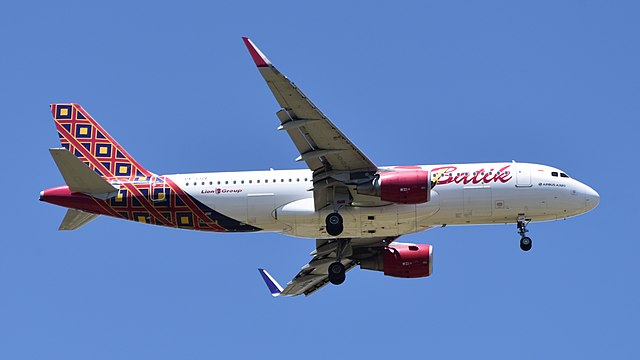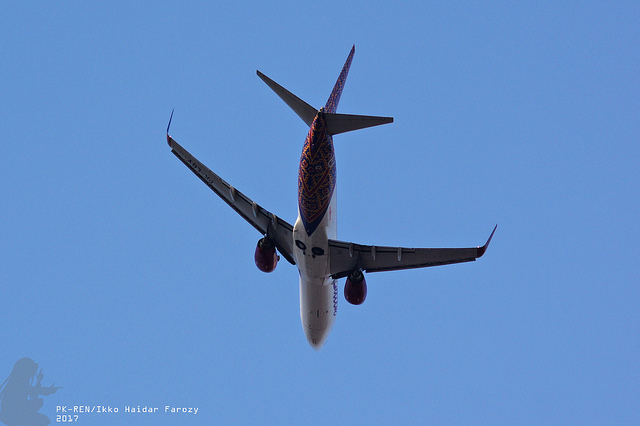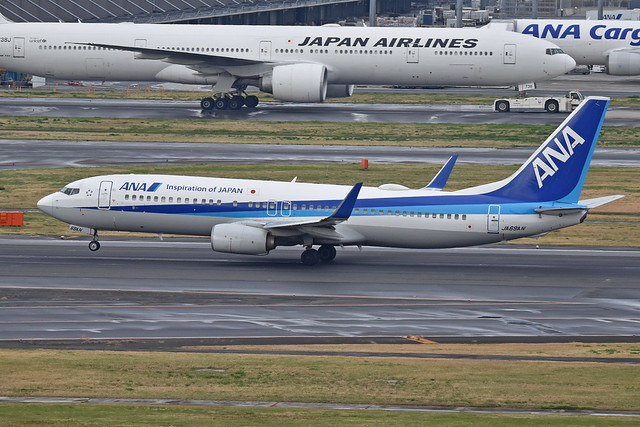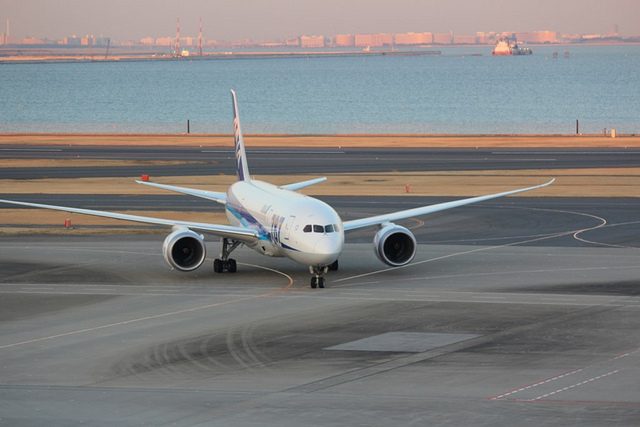Batik B739 at Yogyakarta on Nov 6th 2015, overran runway
Last Update: June 16, 2016 / 15:01:51 GMT/Zulu time
Incident Facts
Date of incident
Nov 6, 2015
Classification
Accident
Airline
Batik Air
Flight number
ID-6380
Departure
Jakarta, Indonesia
Destination
Yogyakarta, Indonesia
Aircraft Registration
PK-LBO
Aircraft Type
Boeing 737-900
ICAO Type Designator
B739
Indonesia's Ministry of Transport reported initial statement from the pilots was the runway was very slippery. The Ministry stated however that of 10 aircraft landing in the present rainy weather only one slipped, so the investigation by NTSC will probably look into human factors rather than weather related issues.
No weather data are available from Yogyakarta at all, local media reports state it was raining heavily at the time of the landing and speak of a "water landing".
On Jun 16 2016 Indonesia's NTSC released their final report concluding the probable causes of the accident were:
Contributing Factors
- The absence of landing distance calculation following landing reconfiguration and the higher speed with no reminder callout might have made the pilots decided to continue landing.
- The conditions of the aircraft floated and eventually touched down at the end of the touchdown zone 13 knots above Vref with average 6 knots tailwind, lower brake pressure for 305 meter after the autobrakes were disconnected, and removal of the thrust reverser application at a higher than recommended speed along with medium braking action had extended the landing distance.
Other Safety Issue
The external factors such as runway condition might have contributed to the reducing of deceleration rate while the brake pressure and thrust reversers were close to maximum.
The NTSC analysed with respect to the decision to land:
After received weather information from the Automatic Terminal Information Services (ATIS) the PF decided to land with flaps 40 and auto-brake max. When the aircraft approaching altitude 2,000 feet, the pilots noticed cumulonimbus cloud over Yogyakarta as indicated by magenta figure on the weather radar and the PF decided to follow wind shear precaution recommendation as described on the Flight Crew Operations Manual (FCOM) to use flaps 30 for landing. This change of landing flap configuration would increase the landing speed and the landing distance. The landing speed for the estimated landing weight of 63,900 kg and flaps 30 was 141 knots. There was no recalculation of the required landing distance following the landing configuration changing.
The recommended elements of a stabilized approach stated in the FCOM, described that the approach in VMC below 500 feet, the aircraft should be in the correct flight path, approach speed deviation of +10 knots to -5 knots are acceptable if the airspeed is trending toward approach speed and all briefings and checklists have been conducted.
The sequence of events below 500 feet when the PF flown the aircraft manually were as follows:
- At 07:59:43 UTC, at altitude 381 feet, the N1s were at approximately 60% and the speed was at 157 knots. At altitude 87 feet, the N1s were increased to approximately 70% followed by the speed increased from 153 knots to 159 knots at 10 feet. At this time the tailwind recorded 6 knots. The aircraft passed altitude 50 feet with speed of 153 knots then at altitude 10 feet the speed increased to 159 knots.
- At 07:59:52 UTC, at 229 feet, the PM advised the PF to fly right and was acknowledged by the PF.
- The time interval between the aircraft passed altitude of 10 feet to touchdown was 6 seconds and the speed was 154 knots.
The decision to land or go around basically rests to the PIC assessment to the possibility of critical condition on landing. The CRM principle requires the PM to callout for any deviation and to take any action if there is no acknowledgement from the PF. In this particular approach, there was no discussion between the pilots concerning to the landing distance following the change of the landing configuration to use flaps 30 for the existing condition, and there was no callout from the PM when the speed was 13 knots above the approach speed. The speed was an indication that one of the stabilize approach element was not achieved and required go around.
A combination of the absence of landing distance calculation for landing configuration with flap 30 and callout of speed above the approach speed might cause the pilots did not aware of the required landing distance for the existing condition and decided to continue landing.
With respect to the landing distance required the NTSC analysed:
The existing condition of Vref that was 13 knots above the target speed and the prolong touchdown resulted in the available runway was not sufficient for the aircraft to stop on medium braking action. On good braking action the runway available would be sufficient with relatively narrow margin. This narrow margin might have occupied by the improper application of brake and thrust reversers which have been discussed on Chapter 2.2. However, there was no information about runway friction classified as good or medium braking action from the air traffic controller or the airport operator which can be used as consideration.
Incident Facts
Date of incident
Nov 6, 2015
Classification
Accident
Airline
Batik Air
Flight number
ID-6380
Departure
Jakarta, Indonesia
Destination
Yogyakarta, Indonesia
Aircraft Registration
PK-LBO
Aircraft Type
Boeing 737-900
ICAO Type Designator
B739
This article is published under license from Avherald.com. © of text by Avherald.com.
Article source
You can read 2 more free articles without a subscription.
Subscribe now and continue reading without any limits!
Read unlimited articles and receive our daily update briefing. Gain better insights into what is happening in commercial aviation safety.
Send tip
Support AeroInside by sending a small tip amount.
Related articles
Batik A320 enroute on Jan 25th 2024, both pilots asleep
A Batik Air Airbus A320-200, registration PK-LUV performing flight ID-6723 from Kendari to Jakarta (Indonesia) with 153 passengers and 6 crew, was…
Batik B738 enroute on Oct 24th 2017, clear air turbulence injures three
A Batik Air Boeing 737-800, registration PK-LBY performing flight ID-6890 from Jakarta to Medan Kuala Namu (Indonesia) with 114 passengers and 7…
Batik B739 near Surabaya on Jan 2nd 2018, turbulence injures 4
A Batik Air Boeing 737-900, registration PK-LBJ performing flight ID-6575 from Surabaya to Jakarta (Indonesia), was climbing through FL230 out of…
Batik B738 at Pekanbaru on May 9th 2017, cabin did not pressurize
A Batik Air Boeing 737-800, registration PK-LBZ performing flight ID-6853 from Pekanbaru to Jakarta (Indonesia) with 91 people on board, was climbing…
Batik B738 and Transnusa AT42 at Jakarta on Apr 4th 2016, collision on runway, both aircraft on fire, takeoff clearance with towed aircraft on runway
A Batik Air Boeing 737-800, registration PK-LBS performing flight ID-7703 from Jakarta Halim Perdanakusuma to Ujung Padang (Indonesia) with 49…
Newest articles
ANA B738 at Yonago on Apr 7th 2024, GPWS saves the day
An ANA All Nippon Airways Boeing 737-800, registration JA69AN performing flight NH-389 from Tokyo Haneda to Yonago (Japan), was on a circling…
ANA B788 at Sapporo on Apr 24th 2024, hydraulic leak after landing
An ANA All Nippon Airways Boeing 787-8, registration JA804A performing flight NH-71 from Tokyo Haneda to Sapporo Chitose (Japan) with 213 people on…
Subscribe today
Are you researching aviation incidents? Get access to AeroInside Insights, unlimited read access and receive the daily newsletter.
Pick your plan and subscribePartner

A new way to document and demonstrate airworthiness compliance and aircraft value. Find out more.

ELITE Simulation Solutions is a leading global provider of Flight Simulation Training Devices, IFR training software as well as flight controls and related services. Find out more.

Your regulation partner, specialists in aviation safety and compliance; providing training, auditing, and consultancy services. Find out more.
AeroInside Blog
Popular aircraft
Airbus A320Boeing 737-800
Boeing 737-800 MAX
Popular airlines
American AirlinesUnited
Delta
Air Canada
Lufthansa
British Airways



